Socio-demographic characteristics of veterans and persons with disabilities in Ukraine
DOI:
https://doi.org/10.31558/2519-2949.2025.3.6Keywords:
veterans and persons with disabilities, integration, reintegration, socio-demographic structure, social protection, psychological and physical rehabilitation, employmentAbstract
The article examines the socio-demographic characteristics of two vulnerable groups of the population of Ukraine, namely veterans and persons with disabilities. During the years of independence, Ukraine has experienced a number of deep socio-political transformations: political crises, economic downturn, two revolutions, an armed conflict in the East and, at present, is undergoing full-scale armed aggression of the Russian Federation. These events influenced the structure of society, led to a sharp increase in the number of people with combat experience, injuries, disabilities and losses in the family. As a result, a new demographic group was formed-veterans of the Russian-Ukrainian war, the number of which is increasing, as well as the number of persons with disabilities received in connection with combat actions, injuries or disability. This necessitates a deep analysis of their socio-demographic portrait, in order to adapt public policy to the new realities of the military and post-war period. Namely, to identify the main trends of the numerical composition, gender and age structure, social status and the level of integration of these groups into society. State policy in this area should be aimed not only at compensation for the losses related to war, disability or disability, but also to create conditions for the full participation of these citizens in public life.It is about ensuring economic independence, independence in everyday life, access to quality social services, medical and psychological rehabilitation, as well as the formation of an active civic position. Equally important is the increase in the level of public respect for veterans and persons with disabilities, overcoming prejudices and promoting their integration through inclusive education, employment and cultural participation. This approach not only reduces social vulnerability, but also realize the potential of these persons as active subjects of restoration and development of the country.
References
Губашов Денис. Портрет ветерана російсько-української війни 2014-2022рр. Український ветеранський фонд. Липень-серпень 2022 року. URL: https://surl.li/aenrkp
Інститут демографії та досліджень якості життя імені Михайла Птухи. URL: https://surl.lu/hhznyl
За 2022-2023 роки кількість людей з інвалідністю зросла на 110-300 тисяч. 02 травня 2025року. Скільки-скільки? URL: https://surl.li/psipqs
Медведенко Леся. Veteran Hub презентує дослідження «Шлях ветеранів та ветеранок.» Армія.inform. 23 вересня 2023 року. URL: https://surl.lu/hvrlyk
Міністерство соціальної політики. URL: https://surl.li/fsqwph
Міністерство у справах ветеранів України. URL: https://mva.gov.ua/
Центр стратегічних комунікацій UCMC. URL: https://spravdi.gov.ua/
Звіт про чисельність ветеранів війни та жертв нацистських переслідувань станом на 01.01.2025. Пенсійний фонд України. 15.03.2025 року. URL: https://surl.li/zatjst
Державна служба зайнятості. URL: https://dcz.gov.ua/
Ливч Дмитро. В Україні частка зайнятості осіб з інвалідністю у 4 рази нижча ніж в ЄС. Як інтегрувати вразливі групи до ринку праці? Рубрика. 21.08.2024 року. URL: https://surl.li/qlvgxs
Захаров Олексій. Міста без бар’єрів. Що заважає доступності для людей з інвалідністю. Humanitarian media hub.13.05.2025 року. URL: https://surl.lu/cgthzt
Підтримка України групою світового банку. WBC. 31.01.2025року. URL: https://surl.li/rllveb
Національна служба здоров’я України.URL:https://nszu.gov.ua/
Денисова Дар’я. Допомога, адаптація, захист. Топ 10 програм компаній для реінтеграції ветеранів. Фокус. 29.04.2025 року. URL: https://surl.li/ntrypr

